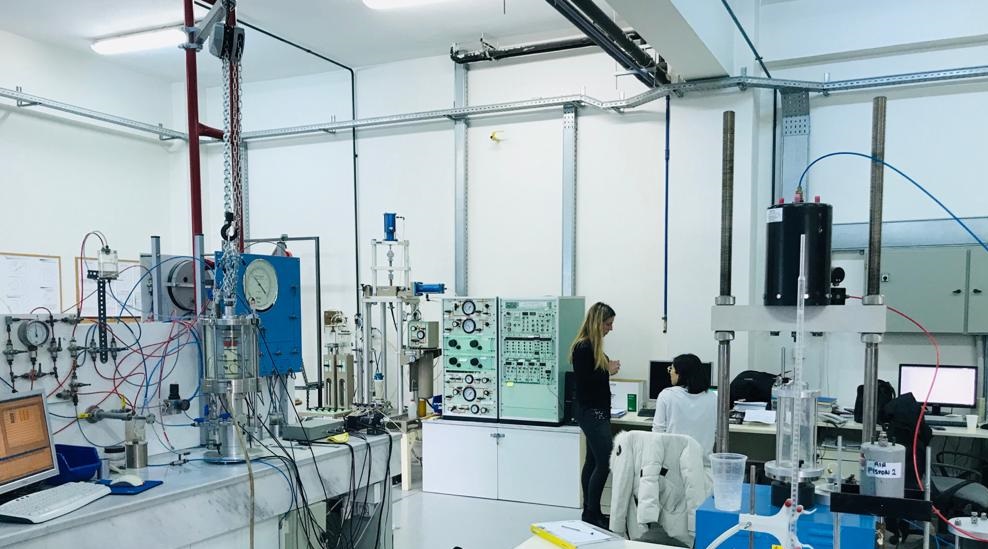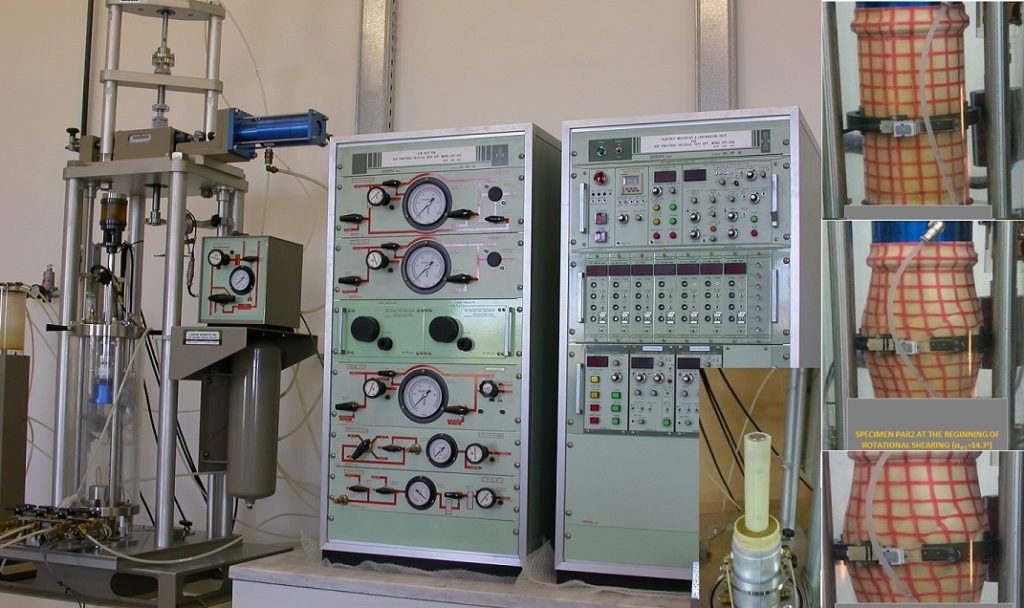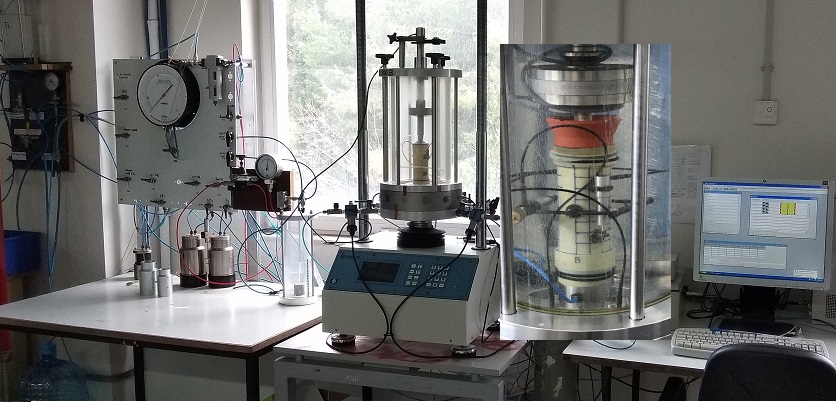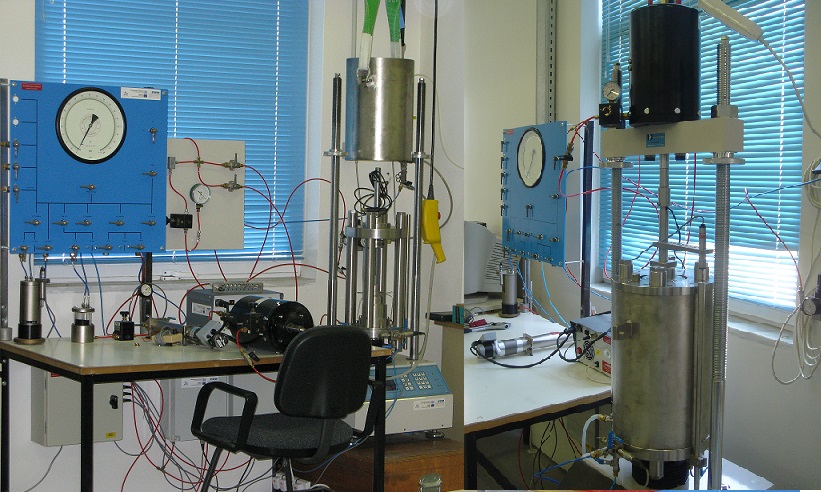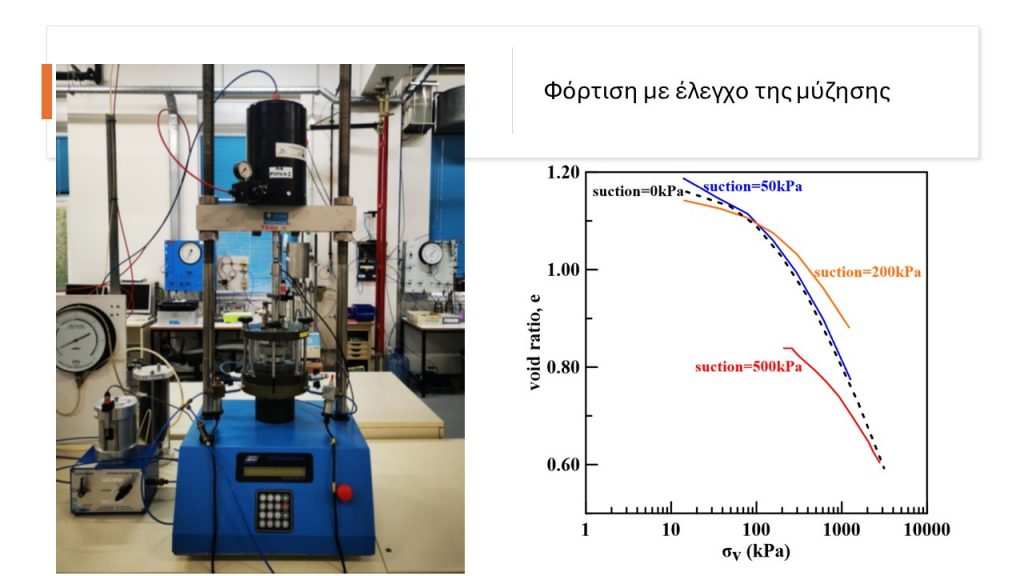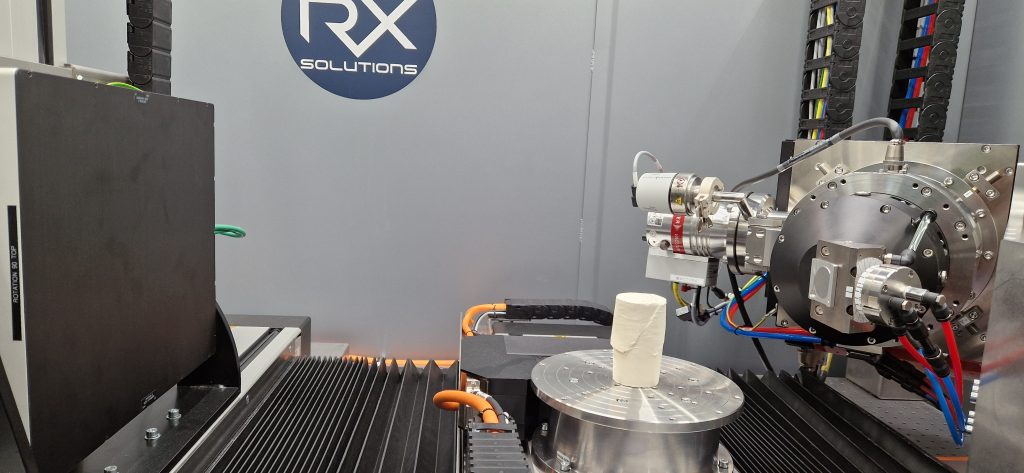Laboratory Facilities
The Geotechnical laboratory at NTUA is equipped with advanced state of the art apparatuses. Locally mounted instrumentation ensures accurate measurements while full automation, developed in the laboratory, allows the design and execution of highly controlled tests. The laboratory facilities are used for research projects and practical applications.
ELEMENT TESTS
Hollow Cylinder torsional apparatus
The HC apparatus imposes generalised monotonic and/or cyclic loading to hollow cylinder specimens under two different modes of operation: static Hollow Cylinder and Dynamic Torsional Shear. The specimens can be isotropically or anisotropically (Ko) consolidated before the application of torsional loading. By controlling the pressure in the internal and external surface of the specimen, the three main stresses σ1, σ2 and σ3 can be independently controlled together with the angle of principal stress rotation. The loading is imposed under stress or strain-controlled conditions by means of pneumatic pistons and air-water interfaces driven by servo controllers. The apparatus, which is unique to Greece, was manufactured by SEIKEN, INC. to the specifications set by NTUA while the control and data acquisition hardware and software systems were solely developed at NTUA.
The load and torque are measured internally. The angle of rotation is measured on the specimen with 0.001% accuracy, while the stresses are determined with 0.5 kPa accuracy. Small axial and radial strains are measured locally. Volume changes are measured inside the sample and the inner pressure compartment. Under dynamic loading, the operational frequencies are between 0.01-1 Hz. HC tests are compiled to simulate the rotation of principal stresses in concurrence with increasing, constant or varying shear stress commonly encountered in soils structures such as foundations, embankments, etc., the cyclic rotation under wave or earthquake loading, the triggering of flow deformation in soil slopes induced by small disturbances under quasi-static conditions, and other more general states of stress. These especially designed highly controlled tests assess anisotropic soil behaviour which is required to develop constitutive models for the prediction of anticipated field paths.
Triaxial Stress Path Cells
The triaxial stress path cells are automatically controlled cells which follow various stress paths and perform static and slow cyclic stress or strain controlled testing for extended periods. The laboratory is equipped with four triaxial stress path cells which can accommodate samples up to 100mm diameter. Apart from standard instrumentation such as internal load cells and volume change transducers, these cells are equipped with special sensors, such as “miniature inclinometers” (to measure the axial deformations on the specimen), a lateral deformation detector (Κo conditions), a mid -height pore pressure probe, and bender elements to measure the Gmax . The overall stability of the system results in a scatter of ± 0.1 kPa and ± 0.05 N in the measurements of cell and pore water pressure and axial load respectively. The local instrumentation leads to the accurate measurement of very small strains (less than 0.005 %). A Bishop & Wesley cell is used for the study of unsaturated soils using suction control.
Medium Pressure Triaxial
Testing stiff clays and/or dense sands which entails considerable increase in cell, pore water pressure and load measuring capacity, necessitates the use of medium pressure triaxial cells e.g. maximum cell pressure of 2000kPa compared to 800kPa in conventional triaxial stress path cells. The cell accommodates specimens with diameters of 50 and 100mm. The overall stability of the system in terms of pressure and axial load measurements is ±0.1kPa and ± 0.5N respectively. Locally mounted LVDTs ensure the accurate measurement of small strains (less than 0.005 %) while full automation allows the implementation of stress path tests including anisotropic consolidation. Ko values are also determined through radial strain measurements.
High Pressure Triaxial
The high pressure triaxial test is used to determine the stress-strain-strength characteristics of very stiff soil and/or weak rock specimens with diameters 50, 75 or 100mm. The maximum cell pressure is 7 MPa and the maximum axial load is 50 kN. The overall stability of the system in terms of pressure measurements is 0.1 kPa for cell pressures up to 4 MPa and 0.5 kPa for higher pressures. The high pressure triaxial cell is equipped with local instrumentation such as “miniature LVDTs”, lateral deformation detector, and bender elements, leading to the measurements of very small strains (less than 0.001% and 0.0005% for static and dynamic measurements respectively). The apparatus is fully automated and testing can be performed under various stress paths, including anisotropic consolidation (Ko), for extended periods of time. Static or slow cyclic stress or strain control can be applied.
Oedometers: High Pressure & Suction Control
An extended range of normal stresses up to 12,5 MPa can be applied as required for the study of the behaviour of natural clays and/or silts within the framework describing the response to normal compression and shearing for reconstituted and intact soils in high pressure oedometers. In unsaturated oedometer tests vertical displacement and volumetric water content are measured either under constant vertical stress and varying matrix suction or increasing vertical stress under constant matrix suction.
Dynamic Triaxial
The GDS Dynamic Cyclic apparatus, which belongs to the Foundations Laboratory, has been set up and upgraded with new pneumatic controllers and local instrumentation for the measurement and control of deformation in the small strain range. Under static loading a range of stress paths can be followed e.g. anisotropic consolidation, pre-shearing, prior to dynamic loading. The main controller of the frame uses an electro-mechanical actuator (ELDYN system) to apply cyclic loading under load and/or displacement control. Dynamic loading is carried out at frequencies between 0.1 Hz to 1 Hz for a range of standard and non-standard waveforms. Load amplitude is maintained within less than 10% of the target for double amplitude axial strain higher than 10% following the onset of liquefaction; at a data logging frequency of 80 Hz.
Bender element applications
The bender element method is used to obtain the elastic shear modulus of a soil, Gmax, by measuring the velocity of propagation of a shear wave through a sample. Bender element systems have been set up in a variety of standard geotechnical laboratory testing equipment (e.g. triaxial and oedometer cells) as well as larger scale testing (e.g. fault rupture box, laminar box, sand box).
Unsaturated Triaxial Testing
Advanced automated triaxial testing systems for unsaturated soils using the Axis Translation Method. Equipped with local strain measurements of axial and radial deformation with accuracy of +/- 1.5μm, a precision differential pressure transducer (range +/- 1.5 kPa) to measure volume change, and an internal load cell. Overall stability of the system 0.1kPa and 0.05N in the measurement of pressures and axial load, respectively.
X-RAY COMPUTED MICRO-TOMOGRAPHY (X-CT)
- X-ray Computed Tomography
Computed tomography (CT) allows experiments to be conducted that provide:
- 3D microstructure mapping: High-resolution imaging of the internal pore network, grain texture and existing defects.
- Quantitative data: AI-image processing is used for quantitative measurements to extract information on crack density, porosity evolution, crack opening, and material phase changes.
The uniqueness of this CT scanner lies in its ability to offer:
- 4D (Real Time) analysis: Scanning of samples during external actions, i.e. 3D imaging of the evolution of the internal structure in real time due to external factors, e.g. loading due to changes in the stress field, water/pollutant, heat, gas flow, etc..
This is achieved on the one hand, due to the large size of the cabin, and on the other, due to the integrated facilities that allow automatic control of the mentioned factors using experimental devices within the cabin of the CT scanner.
Similar CT scanners exist in distinguished research centres abroad to address critical, unresolved challenges in understanding the behaviour of geomaterials, building materials and the geo-environment.
These features are also necessary for industrial applications such as inspecting the internal structure of relatively large test samples or components for defects.
X-ray tubes max power max kV sample dim (max) external dim
resolution: 2μ/4μ 200W 230 D=640mm, H=840mm L=2.86m, D=1.86m, H=2.40m
max sample weight 100kg

